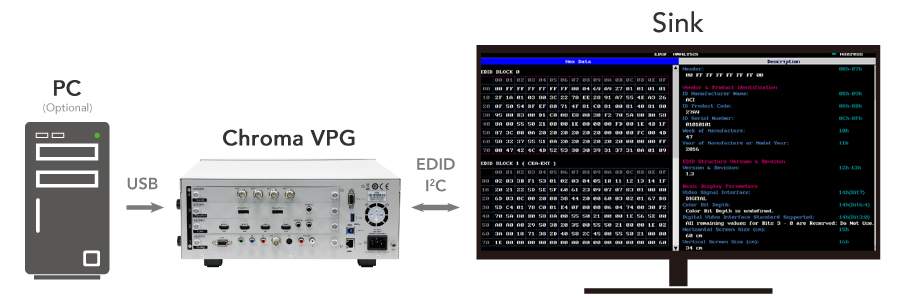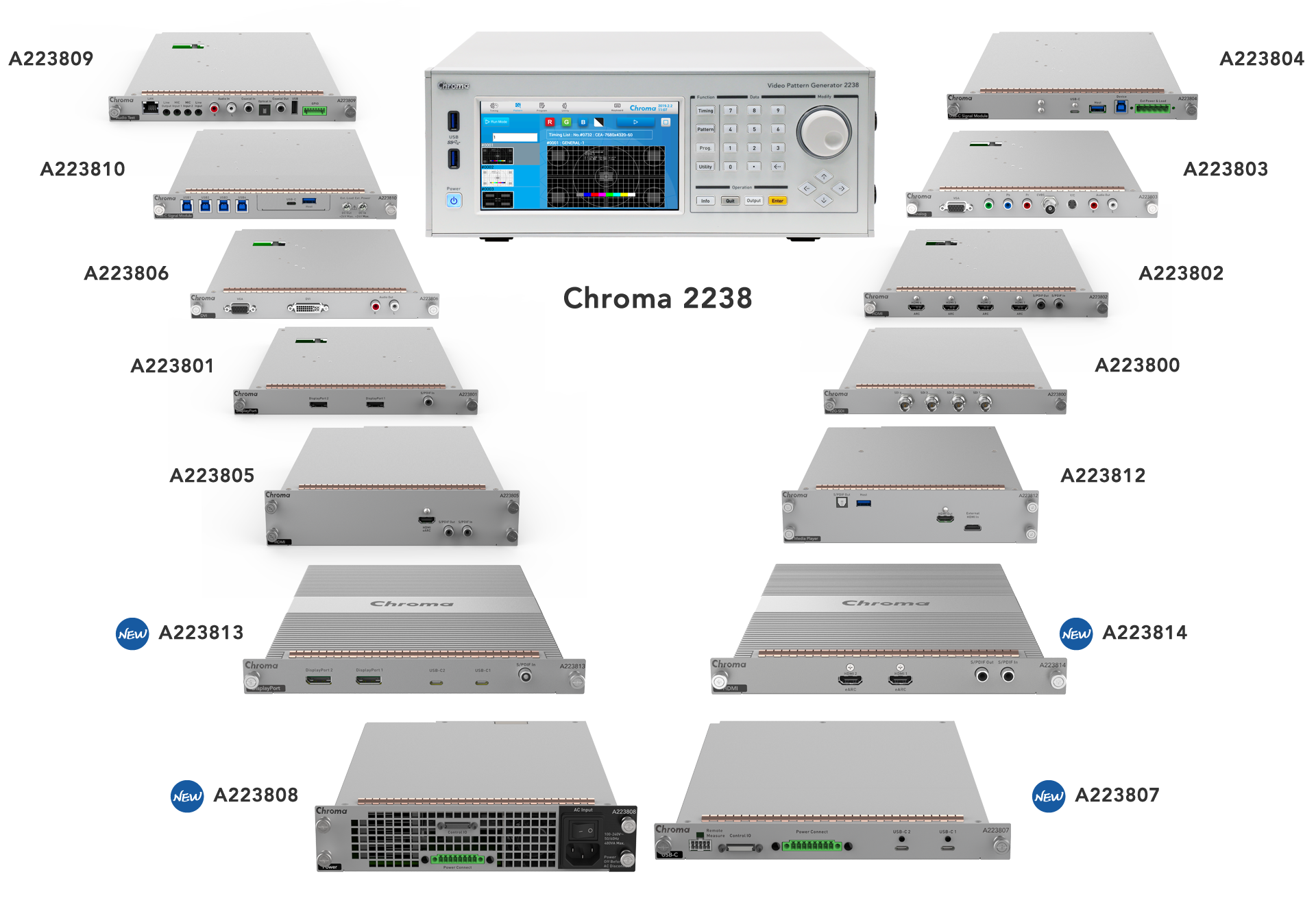
Chroma A223803 features all standard analog video signal output functions, supporting VGA, YPbPr, CVBS, Y/C signals, and Analog Audio interfaces, which can be output simultaneously and perform a variety of testing applications.
With regards to RGB output of the VGA (Video Graphics Array) analog signal, the A223803 follows the VESA VSIS v1.1 specification and conforms to RS-343a, RS-170 and VESA signal standards, with a pixel rate of 300MHz, and a maximum supported display resolution of 2560×1600 (WQXGA).
The A223803's VGA interface supports RGB/R-Y, B-Y/ITU601/ITU709/SMPTE 240M/RP177 gamut outputs. Image Scanning Mode supports Interlaced and Non-interlaced logic combinations.
The YPbPr component port adopts the American Electronics Industry Association’s EIA-770.2a standard, meeting the requirements of high-quality video transmission which the color component interface is designed to facilitate. The design makes intelligent use of the fact that the human eye is more sensitive to brightness than to chromaticity, which makes it difficult to see the difference between the processed image and the original image. Signal Scanning Mode supports Interlaced, Non-interlaced, EQP, SERR and other logic combinations, as well as SD and HD display resolutions.
Chroma A223803 provides a variety of standard TV signal outputs and BNC/S-Video output ports, complies with NTSC, PAL, SECAM specification signals, supports CVBS, Y/C split signal formats, and supports testing of a variety of specialized TV functions.
'Teletext' refers to a television station’s hidden text, graphics and other digital information, stored in the vertical blanking interval (VBI) of the TV program’s broadcast signal. The A223803 features a Teletext testing function, providing users with a variety of TV function testing items.
Closed Captions are subtitles in a TV show or video disc for viewers who, for example, do not understand the language used, have hearing impairments or need to watch the program without sound. Chroma A223803 features a Closed Captioning on/off function, enabling the user to test specific video features.
V-chip refers to technology used by television sets in Canada, Brazil and the United States to block the playback of specific programs based on their content rating, designed to enable parents to manage the content watched by their children. The A223803 has a built-in V-chip function, which can be edited to set up various program properties when testing the DUT.
Chroma A223803 provides a reliable, impartial TV signal module that ensures the quality of the DUT’s signal through NTSC, PAL and SECAM designated detection equipment testing, Signal Voltage Level, Signal-to-noise Ratio and Group Delay measurement, as well as rigorous signal integration testing.
EDID (Extended Display Identification Data) is a VESA-defined data standard for identifying DDC displays. The A223803 directly reads, compares and writes to the EDID register inside the display through I2C, which includes the supplier's information, image size, color setting, and frequency range. At the same time, users can edit the EDID through an external PC's software interface and display the complete analysis results.

Chroma A223803 follows the VESA VSIS 1.1 specification. The RGB output uses a high-order 12 bits digital/analog converter (DAC) to achieve applications beyond the True Color 10-bit specification. The user can customize the Video Level, White Level and Sync Level test signal voltage values. The minimum editable unit of the voltage value is 1 mV, which allows setting up a variety of testing values.
- Video Level editable range: 0 ~ 1000 mV
- White Level editable range: 0 ~ 1200 mV
- Sync Level editable range: 0 ~ -500 mV

*Picture shows maximum output voltage.
Chroma A223803 complies with RS-343a and RS-170 signal standards and can enable or disable 7.5 IRE, using the Pedestal Level as a background brightness test.

The VESA VSIS 1.1 specification requires a response time of less than 1.6 nanoseconds (ns) for the rise/fall of the test signal. The Chroma A223803 screen output test signal’s rise/fall time meets the specification standards, ensuring signal integrity by testing at the highest speed point frequency.
Composite signals can be turned on or off according to user needs, or set to any Sync on RGB setting.
Chroma 2238 Video Pattern Generator integrates complete executable programs with timings, test patterns, and audio that can be configured freely according to testing needs. Not only does the equipment carry up to 2000 timing patterns and 5000 images, users also can add their own test patterns to meet a large variety of test specifications.
The built-in resolution test chart can accurately indicate the correct scale according to different Timings. In addition to geometric shapes and aspect ratio tests (4:3, 16:9), other test patterns such as Color Bar and Grayscale are also included. With these test patterns, users can easily determine the display's imaging quality and simultaneously monitor the HDCP and EDID execution status on the on-screen display, especially useful for R&D, production and QA purposes.
High conductivity beryllium copper improves the conductivity between components and reduces electromagnetic radiation leakage interfering with the DUT, in compliance with CE/EMC (Electromagnetic Compatibility) standards.
Full Line of Chroma 2238 Signal Modules
